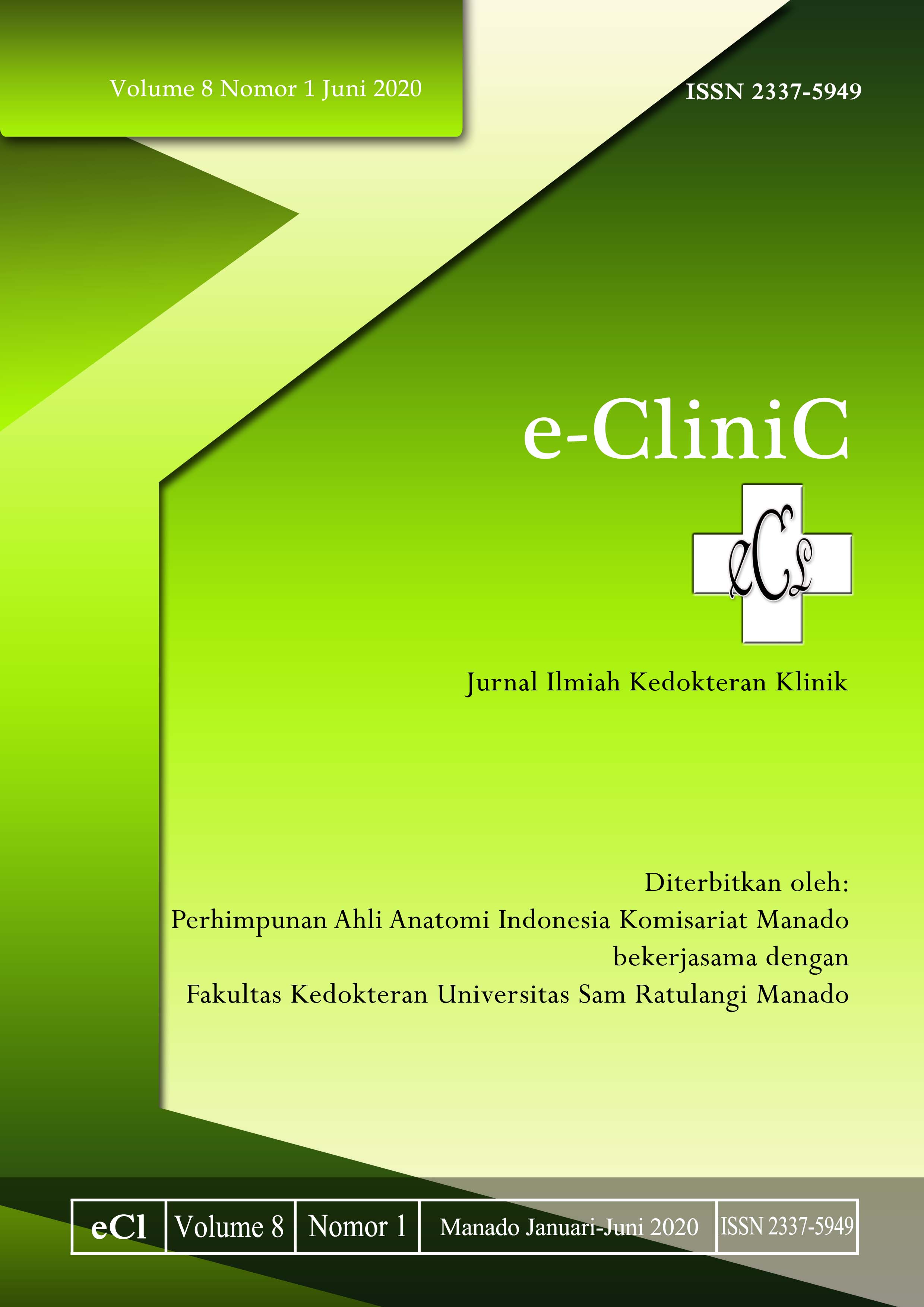Hubungan Kebersihan Kepala dengan Pedikulosis Kapitis pada Komunitas Dinding di Pasar Bersehati Manado
DOI:
https://doi.org/10.35790/ecl.v8i1.28311Abstract
Abstract: Pediculosis capitis is an infection of the skin and hair caused by Pediculus humanus var capitis. This disease mainly attacks young children and spreads quickly in a crowded environment and poor hygiene condition. Transmission are mainly through direct contact head-to-head or indirectly such as combs, hair accessories, pillows, veils, etc. Transmission is increasing with several factors inter alia age, sex, frequency of washing hair, sharing towels, beds as well as goods. This study was aimed to assess the relationship between head hygiene and pediculosis capitis among children fostered in Komunitas Dinding at Pasar Bersehati Manado. This was an analytical and observational study with a cross sectional design. Subjects consisted of 30 children, aged 5-15 years, and met the inclusion and exclusion criteria. Data were analyzed by using the chi-square test. The results showed that of 30 subjects, 18 children (60%) had pediculosis capitis. The chi-square test showed that washing hair with shampoo per week (p=0.100), sharing towels (p=0.618), and sharing beds (p=0.177) did not have significant relationships with pediculosis capitis meanwhile sharing goods (p=0.002) had a significant relationship with pediculosis capitis. In conclusion, there was a relationship between sharing goods and pediculosis capitis among children fostered in Komunitas Dinding at Pasar Bersehati Manado.
Keywords: pediculosis capitis, children, scalp hygiene
Â
Abstrak: Pedikulosis kapitis merupakan infeksi kulit dan rambut kepala yang disebabkan oleh Pediculus humanus var capitis. Penyakit ini terutama menyerang anak-anak usia muda dan cepat meluas dalam lingkungan hidup yang padat dan kondisi higiene yang tidak baik. Penularan terutama secara kontak langsung melalui head-to-head maupun tidak langsung seperti sisir, aksesoris rambut, bantal, kerudung, dll. Penularan semakin meningkat dengan adanya faktor usia, jenis kelamin, frekuensi mencuci rambut, penggunaan handuk bersama, penggunaan tempat tidur bersama, dan penggunaan barang bersama. Penelitian ini bertujuan untuk mengetahui hubungan kebersihan kepala dengan pedikulosis kapitis pada anak-anak binaan Komunitas Dinding di Pasar Bersehati Manado. Jenis penelitian ialah analitik observasional dengan desain potong lintang. Subjek penelitian berjumlah 30 anak, berusia 5-15 tahun yang memenuhi kriteria inklusi dan eksklusi. Data penelitian diuji dengan uji chi-square. Hasil penelitian mendapatkan 18 anak (60%) mengalami pedikulosis kapitis. Uji statistik menunjukkan bahwa mencuci rambut menggunakan sampo per minggu (p=0,100), penggunaan handuk bersama (p=0,618), penggunaan tempat tidur bersama (p=0,177) tidak memiliki hubungan bermakna dengan pedikulosis kapitis sedangkan penggunaan barang bersama (p=0,002) memiliki hubungan bermakna dengan pedikulosis kapitis. Simpulan penelitian ini ialah terdapat hubungan antara penggunaan barang bersama dengan pedikulosis kapitis pada anak-anak binaan Komunitas Dinding di Pasar Bersehati Manado.
Kata kunci: pedikulosis kapitis, anak, kebersihan kepala
Downloads
How to Cite
Issue
Section
License
COPYRIGHT
Authors who publish with this journal agree to the following terms:
Authors hold their copyright and grant this journal the privilege of first publication, with the work simultaneously licensed under a Creative Commons Attribution License that permits others to impart the work with an acknowledgment of the work's origin and initial publication by this journal.
Authors can enter into separate or additional contractual arrangements for the non-exclusive distribution of the journal's published version of the work (for example, post it to an institutional repository or publish it in a book), with an acknowledgment of its underlying publication in this journal.
Authors are permitted and encouraged to post their work online (for example, in institutional repositories or on their website) as it can lead to productive exchanges, as well as earlier and greater citation of the published work (See The Effect of Open Access).







